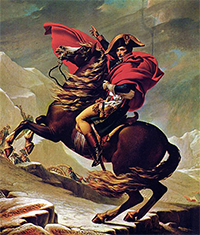The Battle of Marengo
The Battle of Marengo pitted Austrian against French troops in Italy during the War of the Second Coalition. The battle took place on June 14, 1800. 
The war had begun in March 1799, with Austrian and French forces struggling for control of Germany and Switzerland. Russia had entered the war and had joined Austrian forces in Italy, achieving a string of victories including one at Trebbia (left), near the site of an ancient victory by the great Carthaginian Hannibal over Rome. That battle was enough to push French troops back into the Alps, leaving Genoa as a lone site of command. Napoleon Bonaparte had invaded Syria early in that year but had retreated to Egypt, fending off an Ottoman invasion of Alexandria in July. Another change in government occurred in France late in 1799, as a coup, facilitated in part by Bonaparte, overthrew the Directory as the executive arm and replaced it with the Consulate, of which Bonaparte himself was First Consul, the person with the most power. 
Once the government was secure, Bonaparte went himself to Italy, to take command of French forces there. The Austrians under Michael von Melas had besieged Genoa. In mid-May, the French army crossed the Alps via the Great St. Bernard Pass, still covered in snow. After subduing an advance Austrian cadre in the Aosta Valley, the French force seized Milan, Pavia, and other locations, in order to severe the lines of communication of the Austrian forces there. Because Bonaparte's force had not gone to Genoa to raise the siege, the French commander, Masséna, had no choice but to surrender, which he did, on June 4. The Austrians, meanwhile, were concentrating their forces in Alessandria. 
The two armies met on June 14 in the Battle of Marengo. Austrian forces numbered 30,000 men and 100 guns; French forces numbered 22,000 men and 15 guns. A surprise Austrian attack set the tone for the day. Bonaparte, thinking that the Austrians were instead retreating from the area, had dispatched elements of his force in other directions, anticipating entrapment. Consequently, as the battle unfolded, he was late in issuing orders. One of those was to recall Gen. Louis Desaix, whom he had sent some miles to the south, along with 6,000 men. The two sides traded fire throughout the day, and the Austrians got the better of things more than once, consistently pushing the French troops into retreat. Melas, slightly wounded and thinking the battle won, delegated command after issuing what he thought was the final order of victory.  At 5:30 p.m., after the battle had raged all day, Gen. Louis Desaix and his men arrived, dragging nine guns with them. They crashed into the fray, and the surprise was enough to make an immediate impact. A heavy cavalry charge by François Kellermann disrupted the Austrian position further, and the combined assault sent the Austrians reeling backward. In full retreat, they gathered in Alessandria, leaving the field of battle. The following day, Melas agreed to end the conflict in Italy. Austrian casualties numbered 6,500 dead and 8,000 captured; among the 4,700 French dead was Desaix, shot from his horse during the waning stages of the battle. At 5:30 p.m., after the battle had raged all day, Gen. Louis Desaix and his men arrived, dragging nine guns with them. They crashed into the fray, and the surprise was enough to make an immediate impact. A heavy cavalry charge by François Kellermann disrupted the Austrian position further, and the combined assault sent the Austrians reeling backward. In full retreat, they gathered in Alessandria, leaving the field of battle. The following day, Melas agreed to end the conflict in Italy. Austrian casualties numbered 6,500 dead and 8,000 captured; among the 4,700 French dead was Desaix, shot from his horse during the waning stages of the battle.
The victory was an important on militarily for France but also politically for Bonaparte. He named his horse Marengo.
|
|
Social Studies for Kids
copyright 2002–2025
David White




